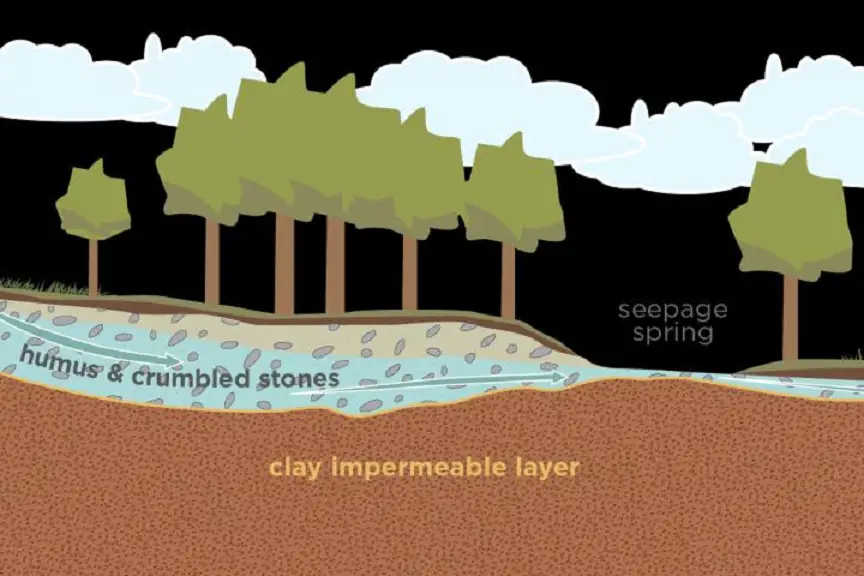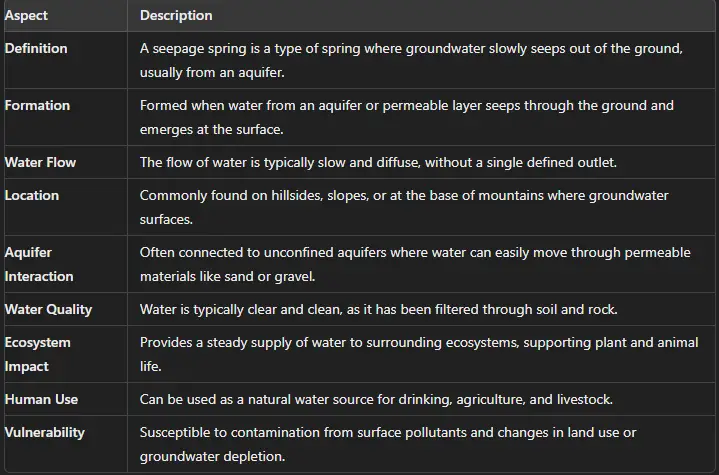Springs and spring water have long been a source of fascination and intrigue and in ancient times philosophers and scientists erroneously believed that springs were formed when saltwater from the oceans moved in tunnels under the land, was purified, and raised to the land surface. Springs were often considered mysterious and are a subject of considerable folklore. What is a Seepage Spring?
Seepage springs or Seeps usually occur in sand, gravel, or organic materials & generally are found in depressions or valley bottoms. Seepage springs are different from artesian springs because they are not necessarily contained below a dense layer of clay or other material & usually have low flows.
For Seepage springs sometimes called Seeps that flow or exit from one spot on level ground, an open-bottomed spring box should be placed over the opening of porous ground to capture all available water flow.
What is a Seepage Spring
A Natural Spring occurs when groundwater appears on the land surface. Springs occur in numerous forms and are classified by the type of rock from which the spring comes.
A Seepage Spring or Seep is a water source that reaches the surface from some underground supply, appearing as small water holes or wet spots on hillsides or along river banks.
Some Seepage springs could fall into more than one category. The flow of water from springs and seeps may come from small openings in the porous ground or from joints or fissures in solid rock.
There are two categories of Seepage (Seeps) springs:
Gravity springs
- Depression springs
- Contact springs; and
- Fracture or tubular springs.
Artesian springs
- Artesian fissure springs; and
- Artesian flow springs

Seepage Natural Springs are formed when groundwater slowly seeps out of the ground. Seepage springs usually occur in sand, gravel, or organic materials and generally are found in depressions or valley bottoms. Seepage springs are different from artesian springs because they are not by definition confined (contained below a dense layer of clay or other material) and usually have lower flows.
The flow of water from Springs and Seeps may come from small openings in the porous ground or from joints or fissures in solid rock. There are three methods of spring development for use as drinking water sources:
- Spring Box-the first, and easiest to install, is the spring box a small area is dug out around the spring and lined with gravel. A concrete box with a removable cover is placed over the spring to collect and store the water.
- Seep Development- if water seeps from the ground and covers an area of several square meters, a third method may be used. Pipes can be laid to collect the underground water and transport it to a collection box. A poured concrete wall just downslope of the pipes can trap the water for more efficient collection.
- Horizontal Wells- where the spring has a steeply sloping water table hydraulic gradient horizontal wells may be used for spring development. Horizontal well intakes must be located in an area with a sloping water table to have adequate discharge.
Natural Spring Capping involves clearing the area & diverting the spring water source from disruption, animals, and contamination in the area immediately above & around the spring …………………………….. Read more
If water seeps from the ground and covers an area of several square meters, a third method may be used. Pipes can be laid to collect the underground water and transport it to a collection box. A poured concrete wall just downslope of the pipes can trap the water for more efficient H2O collection.
A Natural Seepage Spring results from an aquifer being filled to the point that the water overflows onto the land surface. They range in size from intermittent seeps, which flow only after much rain, to huge pools flowing hundreds of millions of gallons daily.
A Spring is a place where H2O moving underground finds an opening to the surface & emerges, as a trickle, after a rain, or continuous flow when the H2O table reaches above the surface level & is classified by the volume of the H2O they discharge.
Types of Springs:
- Perennial
- Intermittent
- Periodic …………………………………………………………… Read more
This Seep water collection method increases maintenance costs as pipes often clog with soil or rocks. Also, the expense and difficulty of construction may prohibit its use. Unless the seep supplies abundant quantities of water, this method should not be considered.
Springs are susceptible to contamination from surrounding land uses. Springs usually are formed near the area where water seeps into the ground. This area is called a “recharge” area.
Since the recharge area is close to the spring outlet, there is inadequate water filtering and removal of contaminants. Common sources of contamination are septic systems, barn yards, fertilizer and pesticides, chemical or petroleum leaks, and old dumps and landfills.
Is the Water From Seepage Springs Safe to Drink?
No. Water quality from springs may vary from year to year and even minute to minute. The Minnesota Department of Health (MDH) routinely sampled springs for coliform bacteria and nitrate-nitrogen during the period of 1960s and 1970s. Coliform bacteria indicate the presence of disease-causing organisms.
Elevated nitrate-nitrogen levels typically result from sewage, animal wastes, or nitrogen fertilizers. Water samples were collected statewide from springs at various times of the year. The results indicated that 85 to 90 % of the sampled springs were contaminated with coliform bacteria or nitrate at one or more times.
Springs are susceptible to contamination from surrounding land uses. Springs usually are formed near the area where water seeps into the ground. This area is called a “recharge” area. Since the recharge area is close to the spring outlet, there is inadequate water filtering and removal of contaminants. Common sources of contamination are septic systems, barn yards, fertilizer and pesticides, chemical or petroleum leaks, and old dumps and landfills.
Periodic testing of springs for bacteria and nitrate has been proven to be generally ineffective in assuring a sanitary water supply because of rapid fluctuations in water quality and because many other possible contaminants may be present in spring water. In most cases, springs have not been tested for pesticides, industrial wastes, petroleum products, or toxic metals. These contaminants may be present in the spring water at one time or another depending upon where the water originates, and land-use practices around the spring.
How do you know if a Spring is Safe to Drink?
You don’t. Natural Springs’ quality & safety can never be guaranteed you should consider all natural water sources as contaminated until tested & limit the water sources where possible, treat the water to make it safe by boiling, disinfection with chlorine, iodine, & ultraviolet light, & filtration ..…………………………………………………. Read more
JimGalloway Author/Editor

References:
Minnesota Department of Health-Seepage Springs
FAQ’s

